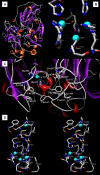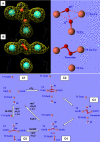Crystal structure of a blue laccase from Lentinus tigrinus: evidences for intermediates in the molecular oxygen reductive splitting by multicopper oxidases
- PMID: 17897461
- PMCID: PMC2064922
- DOI: 10.1186/1472-6807-7-60
Crystal structure of a blue laccase from Lentinus tigrinus: evidences for intermediates in the molecular oxygen reductive splitting by multicopper oxidases
Abstract
Background: Laccases belong to multicopper oxidases, a widespread class of enzymes implicated in many oxidative functions in pathogenesis, immunogenesis and morphogenesis of organisms and in the metabolic turnover of complex organic substances. They catalyze the coupling between the four one-electron oxidations of a broad range of substrates with the four-electron reduction of dioxygen to water. These catalytic processes are made possible by the contemporaneous presence of at least four copper ion sites, classified according to their spectroscopic properties: one type 1 (T1) site where the electrons from the reducing substrates are accepted, one type 2 (T2), and a coupled binuclear type 3 pair (T3) which are assembled in a T2/T3 trinuclear cluster where the electrons are transferred to perform the O2 reduction to H2O.
Results: The structure of a laccase from the white-rot fungus Lentinus (Panus) tigrinus, a glycoenzyme involved in lignin biodegradation, was solved at 1.5 A. It reveals a asymmetric unit containing two laccase molecules (A and B). The progressive reduction of the copper ions centers obtained by the long-term exposure of the crystals to the high-intensity X-ray synchrotron beam radiation under aerobic conditions and high pH allowed us to detect two sequential intermediates in the molecular oxygen reduction pathway: the "peroxide" and the "native" intermediates, previously hypothesized through spectroscopic, kinetic and molecular mechanics studies. Specifically the electron-density maps revealed the presence of an end-on bridging, micro-eta 1:eta 1 peroxide ion between the two T3 coppers in molecule B, result of a two-electrons reduction, whereas in molecule A an oxo ion bridging the three coppers of the T2/T3 cluster (micro3-oxo bridge) together with an hydroxide ion externally bridging the two T3 copper ions, products of the four-electrons reduction of molecular oxygen, were best modelled.
Conclusion: This is the first structure of a multicopper oxidase which allowed the detection of two intermediates in the molecular oxygen reduction and splitting. The observed features allow to positively substantiate an accurate mechanism of dioxygen reduction catalyzed by multicopper oxidases providing general insights into the reductive cleavage of the O-O bonds, a leading problem in many areas of biology.
Figures





Similar articles
-
A crystallographic and spectroscopic study on the effect of X-ray radiation on the crystal structure of Melanocarpus albomyces laccase.Biochem Biophys Res Commun. 2006 Dec 1;350(4):929-34. doi: 10.1016/j.bbrc.2006.09.144. Epub 2006 Oct 5. Biochem Biophys Res Commun. 2006. PMID: 17045575
-
Structural insights into the O2 reduction mechanism of multicopper oxidase.J Biochem. 2015 Oct;158(4):293-8. doi: 10.1093/jb/mvv079. Epub 2015 Aug 12. J Biochem. 2015. PMID: 26272825 Review.
-
The structure of Rigidoporus lignosus Laccase containing a full complement of copper ions, reveals an asymmetrical arrangement for the T3 copper pair.J Mol Biol. 2004 Oct 1;342(5):1519-31. doi: 10.1016/j.jmb.2004.07.100. J Mol Biol. 2004. PMID: 15364578
-
Crystal structure of a laccase from the fungus Trametes versicolor at 1.90-A resolution containing a full complement of coppers.J Biol Chem. 2002 Oct 4;277(40):37663-9. doi: 10.1074/jbc.M204571200. Epub 2002 Aug 5. J Biol Chem. 2002. PMID: 12163489
-
Basic and applied features of multicopper oxidases, CueO, bilirubin oxidase, and laccase.Chem Rec. 2007;7(4):220-9. doi: 10.1002/tcr.20125. Chem Rec. 2007. PMID: 17663447 Review.
Cited by
-
A Fungal Ascorbate Oxidase with Unexpected Laccase Activity.Int J Mol Sci. 2020 Aug 11;21(16):5754. doi: 10.3390/ijms21165754. Int J Mol Sci. 2020. PMID: 32796622 Free PMC article.
-
Reversibility and efficiency in electrocatalytic energy conversion and lessons from enzymes.Proc Natl Acad Sci U S A. 2011 Aug 23;108(34):14049-54. doi: 10.1073/pnas.1103697108. Epub 2011 Aug 15. Proc Natl Acad Sci U S A. 2011. PMID: 21844379 Free PMC article.
-
Laccase engineering by rational and evolutionary design.Cell Mol Life Sci. 2015 Mar;72(5):897-910. doi: 10.1007/s00018-014-1824-8. Epub 2015 Jan 14. Cell Mol Life Sci. 2015. PMID: 25586560 Free PMC article. Review.
-
Nanomaterials as Redox Mediators in Laccase-Based Amperometric Biosensors for Catechol Assay.Biosensors (Basel). 2022 Sep 8;12(9):741. doi: 10.3390/bios12090741. Biosensors (Basel). 2022. PMID: 36140126 Free PMC article.
-
Grouping of multicopper oxidases in Lentinula edodes by sequence similarities and expression patterns.AMB Express. 2015 Dec;5(1):63. doi: 10.1186/s13568-015-0151-2. Epub 2015 Sep 17. AMB Express. 2015. PMID: 26384343 Free PMC article.
References
-
- Yoshida H. Chemistry of Lacquer (Hurushi) part 1. J Chem Soc Tokyo. 1883;43:472–486. doi: 10.1039/ct8834300472. - DOI
Publication types
MeSH terms
Substances
LinkOut - more resources
Full Text Sources
Other Literature Sources
Research Materials
Miscellaneous

